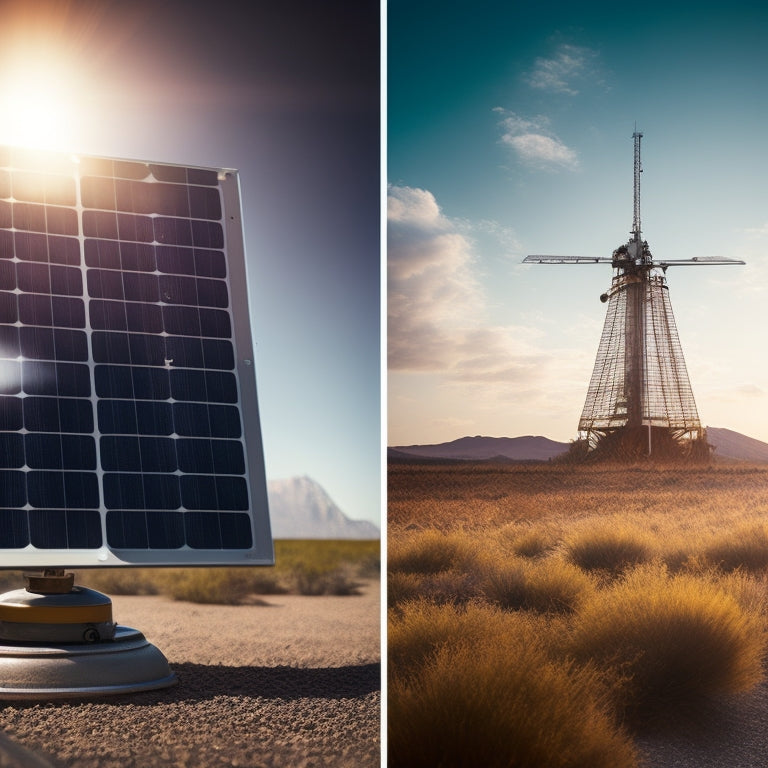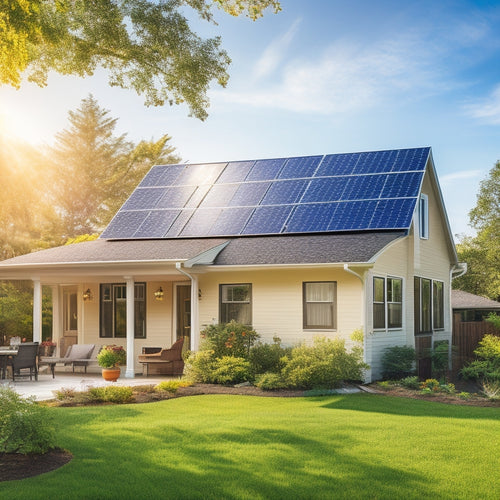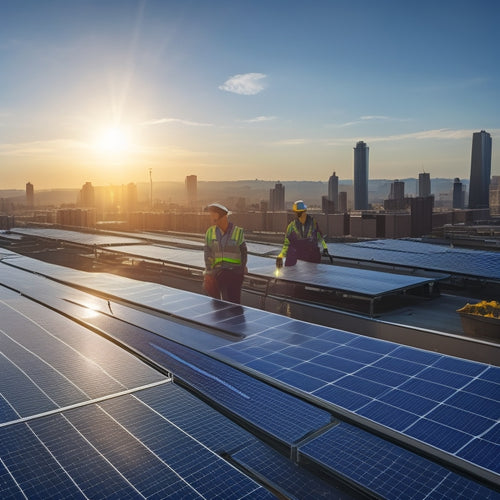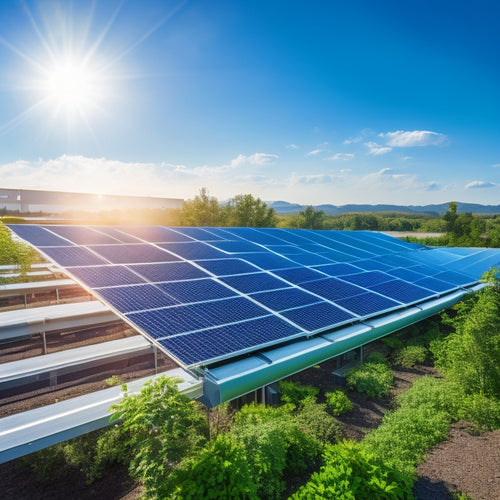
Timing in Solar Installation and Maintenance: When to Act
Share
When it comes to solar installation and maintenance, timing is essential to guarantee peak performance and efficiency. You need to take into account seasonal factors, like winter's lower sun angle and summer's high temperatures, which impact energy generation. Regular inspections and maintenance are fundamental to address weather-related issues, such as storm damage, debris accumulation, and moisture buildup. Scheduling timely system performance checks, ideally every six months, helps detect potential problems early on. By understanding these timing factors, you'll be better equipped to prioritize your solar system's upkeep and maximize its energy output - and there's more to investigate when it comes to fine-tuning your solar strategy.
Key Takeaways
- Consider seasonal variations in sun angle and temperature when installing solar panels to optimize energy generation.
- Perform regular maintenance checks at least every six months to identify potential issues before they escalate.
- Clean solar panels regularly to ensure maximum energy absorption and output, especially during periods of high debris accumulation.
- Schedule inspections during extreme weather conditions to detect signs of wear and damage early on.
- Implement a 24/7 monitoring system to facilitate immediate response to potential problems and minimize downtime.
Seasonal Solar Installation Considerations
As winter approaches, homeowners and solar installers alike must take into account the seasonal implications of solar panel installation.
You'll want to guarantee ideal installation, which involves careful planning to maximize seasonal efficiency.
When installing solar panels during winter, you should account for the lower sun angle, which reduces the amount of energy your system can generate.
To compensate, you may need to install your panels at a steeper angle to capture more energy. This adjustment will help you maintain a reasonable level of energy production during the colder months.
In contrast, summer installations can take advantage of the higher sun angle, resulting in more energy generated per hour.
However, high temperatures can reduce your system's efficiency, so it's crucial to take this factor into account when selecting your equipment.
Weather Conditions and Maintenance
Harsh weather conditions can greatly affect your solar panel system's performance and longevity, so it's vital to maintain your system regularly to guarantee ideal energy production.
You need to be proactive in addressing weather-related issues to verify your system operates at its best.
Some weather conditions that can impact your solar panel system include:
-
Storm impact: Heavy winds and hail can damage your solar panels, reducing their efficiency. Regular inspections can help identify and replace damaged panels.
-
Temperature effects: Extreme temperatures can affect your system's energy output. High temperatures can reduce energy production, while low temperatures can increase it. Proper system design and installation can mitigate these effects.
-
Debris accumulation: Leaves, branches, and other debris can accumulate on your solar panels, reducing their energy output. Regular cleaning can help maintain peak performance.
- Moisture buildup: Humidity and moisture can seep into your system, causing corrosion and damage. Regular maintenance can help identify and address these issues before they become major problems.
Timely System Performance Checks
Your solar panel system's performance relies heavily on regular checks to guarantee it's operating at its finest. Without timely system performance checks, you risk compromising your system's energy output and overall efficiency.
It's essential to prioritize performance monitoring to identify potential issues before they escalate into major problems.
Establishing a regular inspection frequency is key to maintaining peak system performance. You should aim to inspect your system at least every six months, with more frequent checks during periods of extreme weather conditions or high energy demand.
During these inspections, pay attention to signs of wear and tear, such as loose connections, damaged panels, or debris accumulation.
Scheduled Maintenance and Repair
Ideal system performance hinges on a proactive approach to maintenance and repair. By prioritizing scheduled maintenance, you guarantee your solar installation operates at peak efficiency, reducing the likelihood of unexpected downtime and costly repairs.
Preventive measures, such as routine inspections, help identify potential issues before they escalate into major problems.
Some essential tasks to include in your scheduled maintenance routine are:
- Inspecting electrical connections and cables for signs of wear or damage
- Verifying that all system components are securely fastened and properly aligned
- Cleaning panels to promote maximum energy absorption
- Monitoring system performance data to detect any anomalies or trends
Emergency Response and Downtime
Even with a proactive approach to maintenance and repair, unexpected issues can still arise, and system downtime can occur. In these situations, you need a solid emergency response plan in place to minimize downtime and get your solar system up and running quickly.
When system failures happen, every minute counts. You can't afford to waste time trying to figure out what's wrong or who to call. You need a clear understanding of your response strategies and a team that can execute them effectively. This means having a 24/7 monitoring system in place, identifying potential single points of failure, and having an extensive troubleshooting guide.
In the event of an emergency, you should be able to quickly identify the problem, dispatch a technician, and implement a fix. This might involve remote troubleshooting, on-site repair, or even temporary replacement of failed components.
The key is to have a plan that's customized to your specific system and can be executed quickly and efficiently. By having a solid emergency response plan, you can minimize downtime, reduce revenue losses, and guarantee your solar system is generating power when you need it most.
Frequently Asked Questions
What Is the Ideal Tilt Angle for Solar Panels to Maximize Energy Output?
You'll maximize energy output by setting your solar panels at an ideal tilt angle, typically between 25-35 degrees, and making seasonal adjustments to account for the sun's changing position, ensuring you utilize the most power possible.
Can I Install Solar Panels on a Roof With Multiple Skylights?
Savvy solar seekers, scrutinize skylight considerations carefully: if your roof's ridges and hips are sturdy, and skylights are few, you can install solar panels, but guarantee roof compatibility with a thorough assessment to avoid costly complications.
How Often Should I Clean My Solar Panels to Maintain Efficiency?
You should clean your solar panels every 6-12 months to maintain peak efficiency, as dirt and debris can reduce energy output by up to 25%; regular solar panel cleaning is essential for ideal performance and maximum power generation.
Are There Any Local Incentives for Solar Installation and Maintenance?
You'll want to investigate local tax incentives and solar rebate programs in your area, which can considerably offset the upfront cost of installation and maintenance, making your investment even more lucrative and efficient.
Can I Perform Solar Panel Maintenance Myself or Do I Need a Professional?
Did you know 25% of solar panels underperform due to lack of maintenance? You can perform basic DIY maintenance tasks, like cleaning, but for complex issues, consider hiring a professional to guarantee peak energy production and extend your system's lifespan.
Conclusion
As you wrap up your solar installation and maintenance checklist, remember that timing is everything. Don't wait until it's too late - a stitch in time saves nine. Regular checks and proactive maintenance can prevent costly repairs, reduce downtime, and guarantee your system operates at peak performance. Stay ahead of the game and prioritize your solar system's health to reap the benefits of clean, sustainable energy.
Related Posts
-

How to Finance Home Solar Panels
Financing home solar panels offers several strategies to lighten your initial costs while maximizing long-term benefi...
-

Solar Installation Guide for Commercial Properties
Implementing solar energy solutions in your commercial property can lead to significant long-term savings and sustain...
-

Solar Energy Efficiency Improvements for Businesses
Improving solar energy efficiency for your business can lead to considerable cost savings and enhance your sustainabi...


